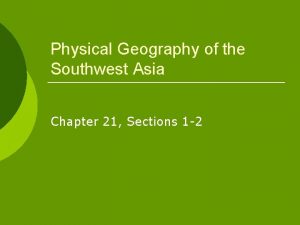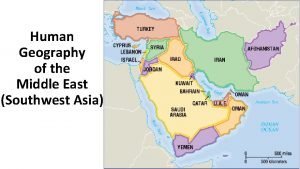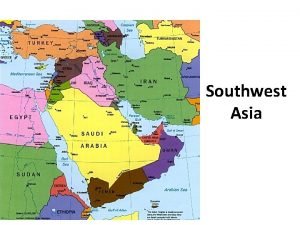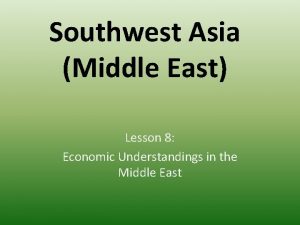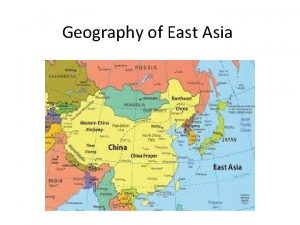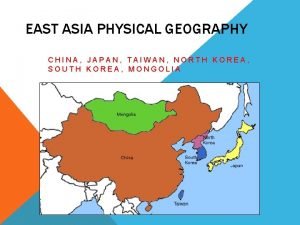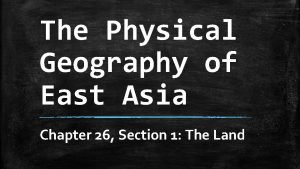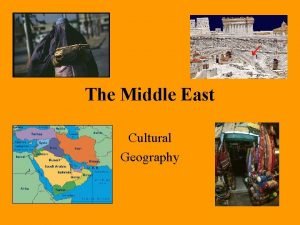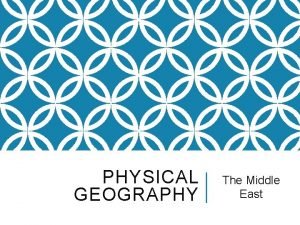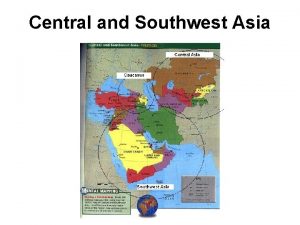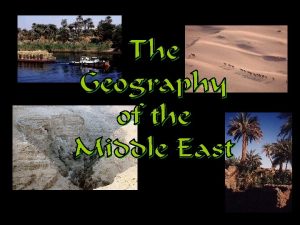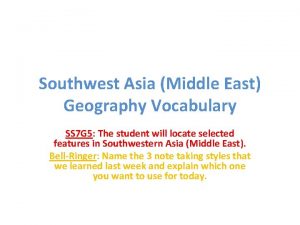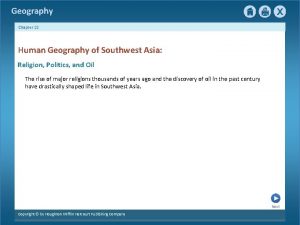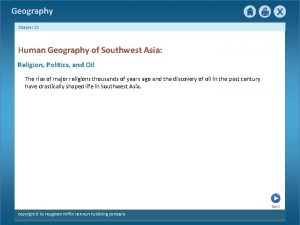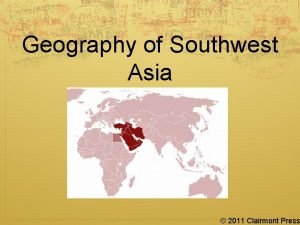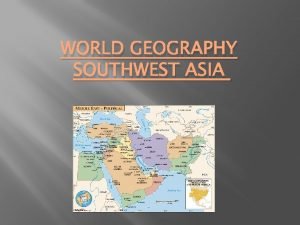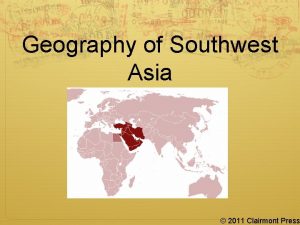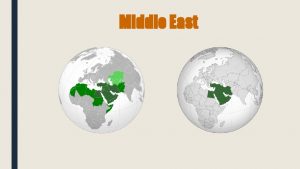Human Geography of the Middle East Southwest Asia














- Slides: 14

Human Geography of the Middle East (Southwest Asia)

Physical Geography of the Middle East • The Middle East ranges from coastal plains to snow-peaked mountains and forms a land bridge between Asia, Africa, and Europe. • The region is almost entirely surrounded by major bodies of water that act as strategic waterways for communication, travel, and trade from Asia to Europe. • Major distinctive landform includes the Arabian Peninsula (which appears to split Africa from Asia) and Anatolian Peninsula (where Turkey is located).

Landforms and Resources • The Tigris and Euphrates Rivers, two of the region’s most important rivers, supported a few ancient river valley civilizations in the Fertile Crescent. The Jordan River provides water, one resource in the entire region. • With very little rain, deserts spreading across the region limited almost all human environment interaction and travel, making life very difficult. Its most famous desert, Rub al-Khali, was named Empty Quarter, or “place where no one comes out”. • Oil has made the Middle East very important, holding ½ of the world’s reserves with the dependency of many global nations. The most valuable resource in many parts of the region, due to its scarcity, is water.

Early Desert Culture • Middle East nomads, called Bedouins, were small groups of people moving from oasis to oasis as they adapted to the harsh desert environment. Often fighting other nomadic clans or families, this eventually helped spread the Islamic religion. • Islam, a monotheistic religion, requires followers to partake in tasks, or the Five Pillars. Around 600 A. D. , Muhammad, the founder of the Muslim religion, was born in Mecca – the holiest city of Islam. This began a more unified Middle East.

Rise of Islam • Islam spread rapidly in the Middle East, Africa, and eventually Europe. The Five Pillars of the faith include faith, prayer, charity, fasting, and a pilgrimage to Mecca. Followers need to pray at least 5 times a day, commit to one god (Allah), donate to charity, and not eat or drink for the holy month of Ramadan. • Muslim culture grew very fast throughout the Middle East, as more and more people converted and worshipped in mosques.

Governments • As Islamic spread and unifying people with Muslim culture, the Middle East was controlled by Muslim empires by the Middle Ages. The governments in control were theocratic, meaning religious leaders ruled and had religious laws. • Modern nation’s law system in the region is based on Shari’ah (or Islamic) law. However, nearing the late 1600 s, leaders of these Muslim nations began to grow weaker while in the meantime, European nation’s power continuously increased.

Colonization • After WWI, much of the Middle East fell to European nations, such as France and Britain as they were seeking to establish empires around the globe. After WWI, Muslims lost control of the Ottoman Empire due to invading colonial powers. • This part of the Middle East was desirable because of trade through the Suez Canal and the oil reserves discovered in areas after 1932. However, Muslim leader, Abdul al-Aziz Ibn Saud , rose to power and reunified many Muslims to combat the Europeans. This recaptured territory turned into the nation of Saudi Arabia.

Regional Oil • As many nations in the Middle East work together after Abdul al-Aziz’s unification, they used oil money to develop other parts of the region, such as water development projects. • Countries work together to coordinate policies or petroleum prices. A specific group of nations partaking in international trade and setting policies and prices is OPEC, or the organization of Petroleum Exporting Countries. OPEC’s purpose is to help the control of the sale of oil, dealing with various price adjustments.

Modernizing - The Middle East rapidly developed through Western technology , but most do not want to forget their traditional ways of lives or cultural identity. - An example would be the change from small business open markets to mall or supercenters or even from traveling by camels to oil powered vehicles. - Majority of people live within the city. Education is lacking which makes it difficult for people to become hired.

Religious Holy Places • Three major religions of Judaism, Christianity, and Islam were founded in the Middle East and all claim Jerusalem as a holy city. • Jewish people travel to pray at the city’s holiest site and only piece of a sacred temple remaining after Romans destroyed it in 70 A. D. , the Western Wall. • For Christians, Jerusalem is a sacred location of Jesus. Christians launched the Crusades, or military campaigns, during the late Middle Ages for control. • A shrine within the city, called Dome of the Rock, is sacred to the Islamic faith. Muslims believe that Muhammed rose to heaven at this location.

Conflict in Israel • After WWII and the Holocaust, the United Nations created a new country, Israel, to give Jews back their former homeland in 1948. The UN wanted to create two countries (one for Jews and one for Arabians) but found resistance. People living there previously were forced to leave to refugee camps in areas like West Bank, occupied by Israel. Surrounding Arab nations invaded but Israeli troops won. • This war in 1948 started hostilities seen today. Terrorist groups, like Palestine Liberation Organization, Hamas, or Hezbollah, formed to reclaim or destroy Israel.

A Blend of Cultures • Many cultures, even some of the earliest civilizations and empires, developed within the area of Mesopotamia, “the land between the rivers”, because of nearby rivers, lakes, and seas. • The Kurds became a stateless nation, a large ethnic group without a country, spread widely over Middle Eastern nations. Victims of a chemical weapons attack by dictators like Saddam Hussein, they are still denied a country for their own. • After Muhammad’s death, Muslims split into the Sunni (85%) and Shi’ite (15%) currently living within the region. Most Shi’ites live within Iran.

Modern Warfare • In a fight over oil-rich regions on the Persian Gulf, Iran and Iraq started a war for control of the oil fields in the 1990 s. In 1992, Iraq invaded Kuwait starting the first Persian Gulf War, involving the U. S. and 32 other nations to force Iraqis out. • In 2001, the U. S. overthrew the Taliban, a Muslim political group protecting Osama bin Laden and al-Qaeda terrorist group, in Afghanistan to help setup a stable government. • In 2003, the U. S. declared war on Iraq to remove Saddam Hussein from power for building weapons of mass destruction and funding al-Qaeda. Hussein did neither of the two but the U. S. continues to help stabilize Iraqi’s government.

The Middle East Today • The Middle East grew wealthy from oil, creating new jobs for construction, technology, and urban development. “Guest workers”, largely unskilled laborers, were hired but nations are developing human resources, or the skills and talents of people, realizing to invest in education, technology training, and women. • The world’s industries and travel needs oil, a strategic commodity or resource so important nations will go to war for a steady supply. Kuwait offers free education. • Even with strict rules in some Arab societies, the worker shortage gives women job opportunities.
 Chapter 22 human geography of southwest asia
Chapter 22 human geography of southwest asia Kums definition geography
Kums definition geography Map of southwest asia
Map of southwest asia Human geography of middle east
Human geography of middle east Chapter 21 physical geography of southwest asia
Chapter 21 physical geography of southwest asia Lesson 8 middle east and south asia
Lesson 8 middle east and south asia Geography of asia
Geography of asia Physical geography of east asia
Physical geography of east asia Chapter 27 physical geography of east asia
Chapter 27 physical geography of east asia Physical geography of east asia
Physical geography of east asia Kalahari desert on africa map
Kalahari desert on africa map Ethnic groups in the middle east
Ethnic groups in the middle east Physical geography of middle east
Physical geography of middle east Chapter 25 section 3 nepal and bhutan
Chapter 25 section 3 nepal and bhutan Brain wrinkles southwest asia
Brain wrinkles southwest asia


